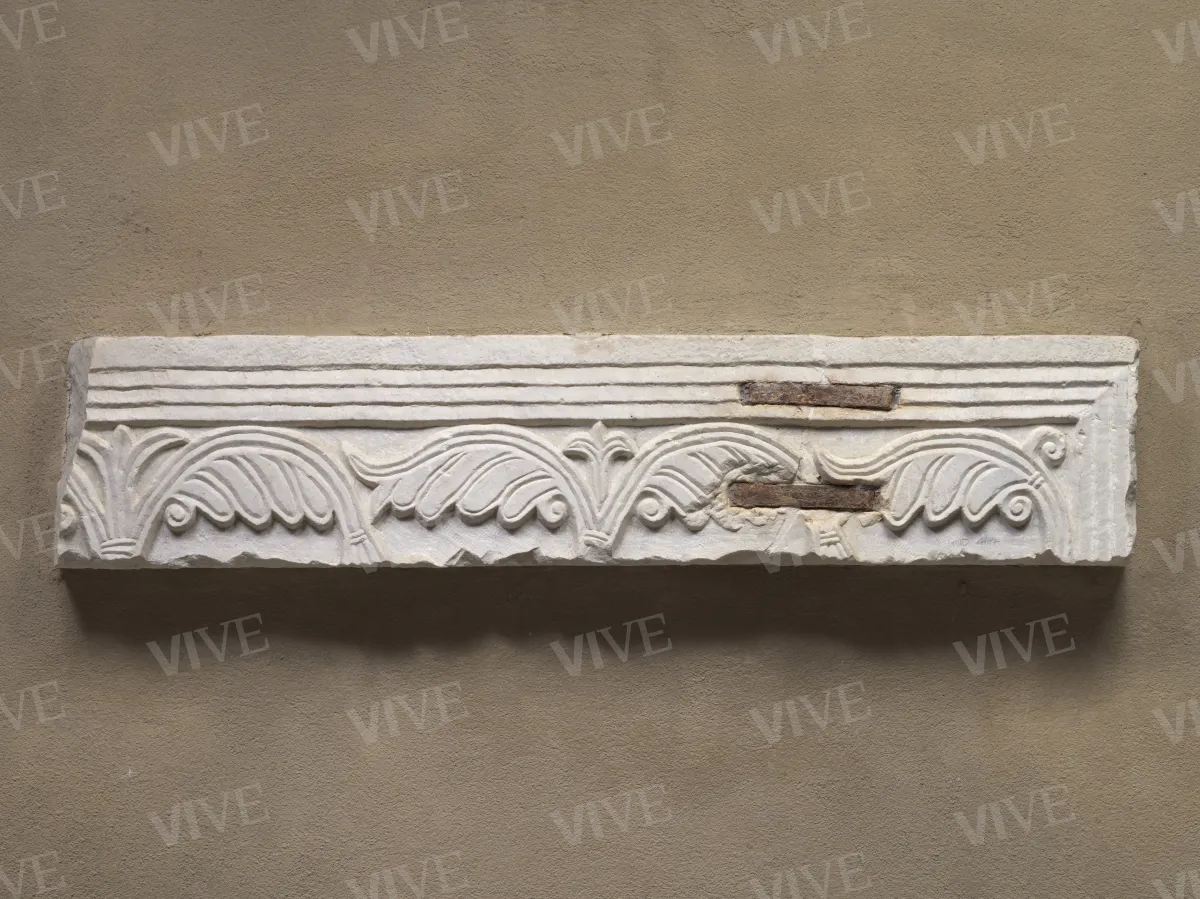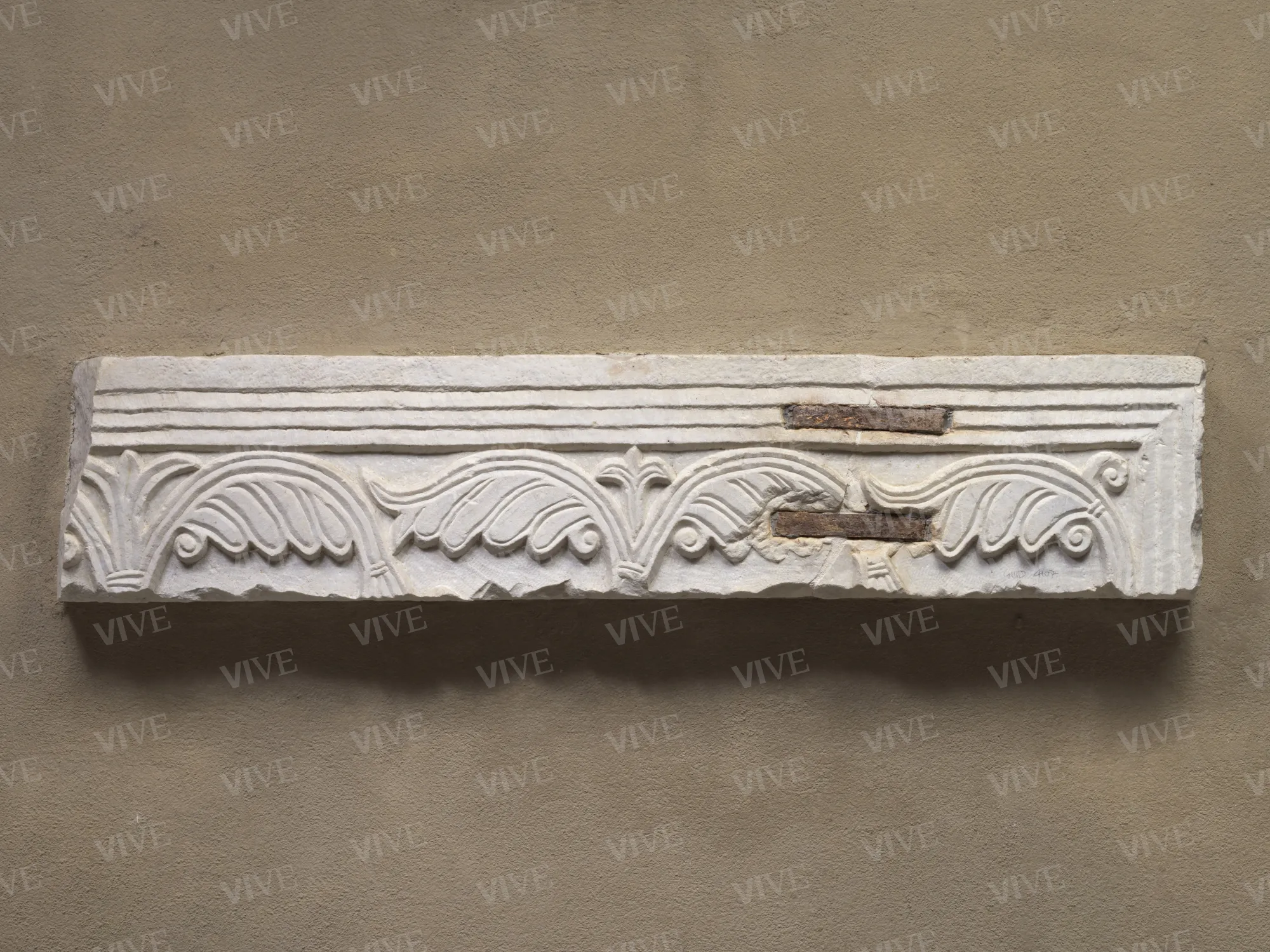Two fragments of marble slab with cornucopia motif
Roman milieu First three decades of 9th century
Two fragments of a marble slab decorated with a two-lined wickerwork cornucopia motif ribbon with cauliculated plant swirls and polylobate pendulous leaves, stylized and joined by bands, within a sawtooth frame.
Two fragments of a marble slab decorated with a two-lined wickerwork cornucopia motif ribbon with cauliculated plant swirls and polylobate pendulous leaves, stylized and joined by bands, within a sawtooth frame.
Details of work
Catalog entry
The two marble fragments, held together by metal clamps and decorated with a two-lined wickerwork cornucopia motif ribbon and stylized plant swirls of polylobate pendulous leaves with ribbon carving and caulicules, within a sawtooth frame, most likely constituted the corner section of a pluteus.
The slab is chipped along the lower edge, which has resulted in the loss of original ornamentation, transforming the cornucopia-like scroll with plant swirls of opposing polylobate leaves (for the Roth-Rubi 2018 motif) into a sequence of acanthus shoots reminiscent of the "butterfly" palmette motif, popular in the Roman sculpture of liturgical fixtures from the age of Leo III (795–816) (Macchiarella 1976, fig. 277), then fully in use with Paschal I (817–824) and Eugene II (824-827) in Santa Sabina (Trinci Cecchelli 1976, figs. 246-247), and shared in the same period over a broad range of Carolingian sculpture in northern Italy, as in the plutei of the presbyterial enclosure of Patriarch Maxentius (811–833) in the basilica of Aquileia (Tagliaferri 1981, fig. 12; Roth-Rubi 2015).
Our fragment bears traces of an early traditional decoration in its original formulation, representing the stylized and geometrized translation of the arbor vitae, or Tree of Life (Gen. 2:8-10; Rev. 22:2).
Carolingian sculpture retrieves different variants of this motif, which was attested in the eastern area as early as the proto-Byzantine age (Verzone 1963). One mutation is the progressive reduction of the phytomorphic element by formalizing it in the pinwheel motif, attested from the Hadrianic liturgical furnishings of Saint Cornelia (Melucco Vaccaro, Paroli 1995; Paroli 2001, but in Melucco Vaccaro 2001 the second quarter of the ninth century). A different variant, formally similar to Pavia's Lombard-era precedents of lush, inhabited girals (Lomartire 2017, but see also Roth-Rubi 2018, according to whom the motif is already in a mature form in the last quarter of the eighth century), is the one that characterizes our fragment and is attested in the Carolingian koiné, from the Reichenau to the Umbro-Latium area, from the late eighth century (Roth-Rubi 2015; Roth-Rubi 2020).
The motif is fully reflected in Roman sculptural production of the first quarter of the ninth century. The most convincing comparisons on a typological level can be established with a fragment of a pluteus from Ferentino (Ramieri 1983, fig. 38) and another from Giulianello di Cori (Betti 2014, fig. 138a; Ballardini 2019, fig. 18a), dated thanks to an inscription to the time of Leo III (795–816) and attributed to masters of Roman provenance (a "guiding fossil" of interlaced sculpture according to Ballardini 2019). However, the most direct formal model remains the pluteus of Santa Prassede (Pani Ermini 1974, fig. 61), part of the presbyterial enclosure of Paschal I (817–824), which, as noted recently (Ballardini 2017), compared to the Giulianello di Cori example, has leaves incised on the margins and not kerbschnitt traced, which is a type of carving—as in our fragments—reserved for the plant shoot alone.
Further confirmation that the fragments belong to the chronological sphere of Paschal I comes from the connection between the motif of opposed polylobate leaf whorls and the sawtooth frame, which is consolidated in the repertoire of the workshops of Paschal I (817–824) operating seamlessly under the patronage of Eugene II (824–827) (Ballardini 2008) (Ballardini 2008). Moreover, the association of beveled trellis and engraved leaves has an ideal counterpart in the butterfly palmette that closes the spandrel of the ciborium arch from the church of Santi Giovanni e Paolo di Ferentino (Ramieri 1983, fig. 13), attributed on the basis of an inscription to workers active in Rome for Paschal I (817–824).
All this supports a possible dating of these fragments to the first three decades of the ninth century, with an additional fact regarding the original use for our finds—in fact, we hypothesize that they were part of a pluteus slab closely related to that of the pluteus fragment (inv. 13606) preserved in the Lapidarium of Palazzo Venezia and originally bearing a typical Korbboden (as defined by Kautzsch 1939) or circle-rhombus-cross motif (Roth-Rubi 2015). It is highly probable that these three pieces belonged to the same liturgical furnishings, probably plutei of a presbyterial enclosure (the thickness of the slabs would be consistent with this, at 8.9 and 8.5 cm), decorated by an iconographic system recurring in Carolingian sculptural production and not only in Rome (specimens recovered by Roth-Rubi 2018) especially around 820 where it was declined according to different artistic orientations, characterized by a common semantic bearing connected to Christ’s redemptive function.
Valentina Brancone
Entry published on 12 February 2025
State of conservation
Mediocre. Cropped and chipped along half of the design for repurposing. The two slab fragments are held together by metal brackets.
Restorations and analyses
1999 (cleaning).
Provenance
Unknown. Found during work on the Palazzetto, as part of the demolitions carried out in the area to relocate the Palazzetto di Venezia (1910–1914).
Sources and documents
Rome, Archivio del Museo del Palazzo di Venezia, inventorying the sculptures of the lower and upper loggias (manuscript inventory edited by Maria Vittoria Brugnoli, 1973).
References
Kautzsch Rudolf, Die römische Schmuckkunst in Stein vom 6. bis zum 10 Jahrhundert, in «Römisches Jahrbuch für Kunstgeschichte», III, 1939, pp. 3-73;
Verzone Paolo, La scultura decorativa dell’Alto Medioevo in Oriente e in Occidente, in Corsi di cultura sull’arte ravennate e bizantina, X, Ravenna 1963, pp. 317-388;
Pani Ermini Letizia, La Diocesi di Roma, t. I, La IV regione ecclesiastica, Corpus della scultura altomedievale, VII, Spoleto 1975;
Trinci Cecchelli Margherita, La Diocesi di Roma, t. IV, La I regione ecclesiastica, Corpus della scultura altomedievale, VII, Spoleto 1976;
Macchiarella Gianclaudio, Note sulla scultura in marmo a Roma tra VIII e IX secolo, in Istituto di Storia dell’Arte dell’Università di Roma (a cura di), Roma e l’età carolingia. Atti delle giornate di studio (Roma, 3-8 maggio 1976), Roma 1976, pp. 289-299;
Tagliaferri Amelio, La Diocesi di Aquileia e Grado, Corpus della scultura altomedievale, X, Spoleto 1981;
Ramieri Anna Maria, La Diocesi di Ferentino, Corpus della scultura altomedievale, IX, Spoleto 1983;
Melucco Vaccaro Alessandra, Paroli Lidia, La Diocesi di Roma, t. VI, Il Museo dell’Alto Medioevo, Corpus della scultura altomedievale, VII, Spoleto 1995;
Paroli Lidia, La scultura a Roma tra il VI e il IX secolo, in Arena Maria Stella, Delogu Paolo, Paroli Linda et al. (a cura di), Roma dall’Antichità al Medioevo. Archeologia e storia nel Museo Romano Crypta Balbi, vol. I, Milano 2001, pp. 132-143, 487-493;
Melucco Vaccaro Alessandra, Le botteghe dei lapicidi: dalla lettura stilistica all’analisi delle tecniche di produzione, in Roma nell’Alto Medioevo. Settimane di studio del Centro italiano di studi sull’Alto Medioevo (27 aprile-1 maggio 2000), XLVIII, vol. I, Spoleto 2001, pp. 393-420;
Ballardini Antonella, Scultura per l’arredo liturgico nella Roma di Pasquale I: tra modelli paleocristiani e Flechtwerk, in Quintavalle Arturo Carlo (a cura di), Medioevo: arte e storia, X Convegno internazionale di studi (Pavia, 18-22 settembre 2007), Milano-Parma 2008, pp. 225-246;
Betti Fabio, Testimonianze scultoree carolinge a Cori e nel suo circondario, in Righetti Marina (a cura di), Una strada nel Medioevo. La via Appia da Roma a Terracina, Roma 2014, pp. 139-150;
Roth-Rubi Katrin (in collaborazione con Sennhauser Rudolph), Die frühe Marmorskulptur aus dem Kloster St. Johann in Müstair, Ostfildern 2015;
Ballardini Antonella, Scultura in pezzi: appunti sulla scultura altomedievale di Santa Prassede, in «Summa», 9, 2017, pp. 5-28;
Lomartire Saverio, La scultura nella Langobardia maior, in Brogiolo Gian Pietro, Marazzi Federico, Giostra Caterina, Longobardi. Un popolo che cambia la storia, catalogo della mostra (Pavia, Castello Visconteo 1 settembre-15 dicembre 2017), Milano 2017, pp. 302-309;
Roth-Rubi Katrin, Die frühe Marmorskulptur von Chur, Schänis und dem Vinschgau (Mals, Glurns, Kortsch, Göflan, Burgeis und Schloss Tirol), Ostfildern 2018;
Ballardini Antonella, Scolpire a Roma per Pasquale I (817-824)? L’Oratorio di San Zenone, in «Hortus artium medievalium», 25, 2019, pp. 376-391;
Roth-Rubi Katrin, La scultura nella Rezia, il suo legame con l’Italia e il Rinascimento carolingio, in Ammirati Serena, Ballardini Antonella, Bordi Giulia (a cura di), Grata più delle stelle. Pasquale I (817-824) e la Roma del suo tempo, vol. 2, Roma 2020, pp. 111-127.












